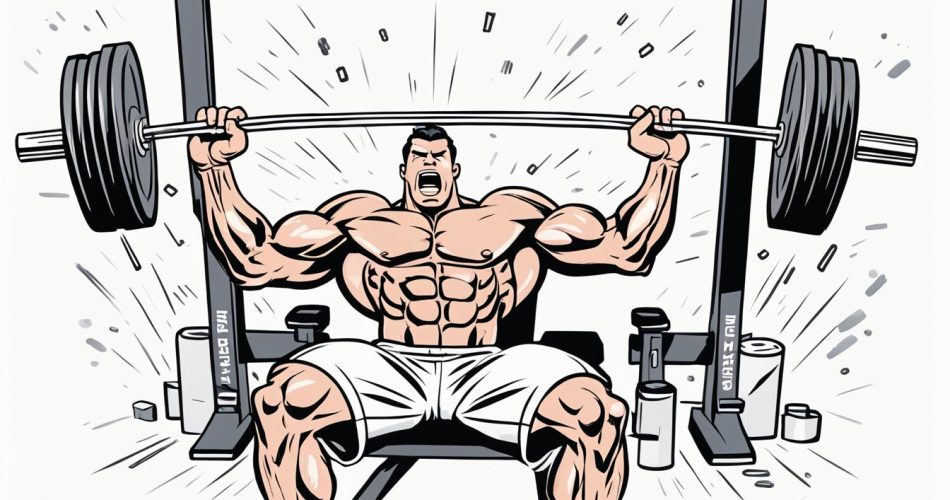As someone constantly striving to enhance my physical strength and muscular definition, I’ve learned that muscle building workouts are the bedrock of realizing these goals. It’s about more than just pushing weights; it’s a meticulous practice of strength training with a game plan. I’m sharing insights on the most effective hypertrophy training plans that help achieve tremendous growth through the principle of progressive overload training. By incorporating these best workout programs for muscle growth into my regimen, I’ve seen firsthand the transformative power of dedicated exercise.
Diligence and consistency are crucial, and I find that balancing my routines with compound and isolation movements two to three times weekly per muscle group has been pivotal. The weight needs to be just enough so that the final reps feel challenging yet doable. Free weights, resistance machines, and even body-weight exercises form an integral part of my progressive journey towards building muscle. And let’s not forget, rest days are sacred—they’re when the magic really happens for muscle recovery and growth.
Key Takeaways
- The importance of muscle building workouts for strength and size enhancement.
- Utilizing progressive overload to continuously challenge muscles.
- Striking a balance between workout frequency and rest for optimal muscle growth.
- Incorporating a mix of compound and isolation exercises in strength training regimens.
- Choosing the right weight for exercises—one that challenges but is achievable.
- The significance of rest days for muscle recovery and development.
Understanding Muscle Hypertrophy: The Foundation of Building Muscle
Unlocking the secrets to substantial muscle gain workouts lies in the biological process of muscle hypertrophy. It’s the cellular science behind every set, rep, and sweat drop during your muscles development workouts. Before diving deep into the mechanisms that drive size and strength enhancements, let’s explore the essentials of muscle hypertrophy.
Defining Muscle Hypertrophy
Muscle hypertrophy is, simply put, the increase in the size of muscle cells. It’s the result I see when I commit to effective muscle building exercises as part of a structured training program. When I place my muscles under stress, microscopic damage occurs, signaling my body to respond by repairing and reinforcing the muscle fibers, ultimately leading to their growth in both diameter and length.
The Role of Progressive Overload
To foster continual muscle development, I implement the principle of progressive overload in my regimen. That means I gradually elevate the demands on my muscles each week. Whether it’s by adding weight, increasing the number of repetitions, or altering the intensity of the exercises, these deliberate increments ensure my muscles are relentlessly challenged, carving a clear path toward growth and strength.
Frequency and Recovery: Balancing Act
A meticulous balance of frequency and recovery is vital in muscle gain workouts. In my experience, hitting each muscle group twice weekly has proven optimal. This frequency gives my muscles a taste of the stress needed to grow without the burnout from overtraining. Recovery is just as crucial; it’s the unsung hero that allows muscle repair and growth, ensuring I come back stronger in every subsequent session.
| Muscle Group | Weekly Frequency | Progressive Overload Strategy | Importance of Recovery |
|---|---|---|---|
| Chest | 2 Sessions | Increase weight or reps | Essential for growth |
| Back | 2 Sessions | Vary exercises | Prevents overtraining |
| Legs | 2 Sessions | Change intensity | Allows muscle repair |
| Arms | 2 Sessions | Add sets | Reduces injury risk |
Incorporating these principles into your muscle gain workouts ensures a solid foundation for muscle hypertrophy. Muscles growth is a journey of consistent effort, and by understanding the science of hypertrophy, you’re one step closer to mastering effective muscle building exercises.
Strategizing Your Strength Training: Approaches for Optimal Growth

As I delve deeper into the nuances of bodybuilding routines, it’s become clear that the secret lies in the blend of complexity and simplicity. The most effective approach is grounded in basic principles that have stood the test of time while allowing for strategic variation to keep my muscles guessing and growing.
Importance of Compound Movements
My routine sets off with the powerhouse of all strength training exercises – compound movements. These are the multi-joint exercises like squats and deadlifts that not only call on major muscle groups but also engage the smaller, supportive ones. They’re the cornerstone of my workout, and I credit them for much of my strength gains.
Exercise Selection and Variation
While compound movements provide the foundation, I certainly don’t stop there. Variety is the spice of life, and the same goes for strength training exercises. I thrive on switching things up, incorporating different exercises that target various muscle groups. This not only keeps the workouts fresh and engaging but also prevents my body from hitting a dreaded plateau.
Manipulating Reps, Sets, and Intensity
Lastly, the principle of progressive overload training is a game-changer. It’s not about lifting the heaviest weights right out of the gate; it’s about the incremental increases over time. Whether it’s adding more weight, increasing reps, or changing the rest periods between sets, these tiny tweaks make all the difference between stagnation and growth.
| Exercise | Sets | Reps | Notes |
|---|---|---|---|
| Deadlifts | 3 | 8-10 | Focus on form, drive through heels |
| Squats | 4 | 8-12 | Keep chest up, engage core |
| Overhead Press | 3 | 6-8 | Steady pace, avoid locking elbows |
| Barbell Rows | 3 | 8-12 | Keep back parallel to ground |
Muscle Building Workouts: Crafting Your Routine
When I think about creating the best workout programs for muscle growth, my focus turns toward compound weightlifting exercises. These movements engage multiple muscle groups, making them the bedrock for a solid muscle-building routine. For example, a push/pull/legs split can provide a comprehensive approach to training that targets all the critical areas of the body. Let’s break down what a typical week might look like:
- Push Day: I focus on upper body pushing muscles like the chest, shoulders, and triceps with exercises such as bench presses and overhead presses.
- Pull Day: This is dedicated to upper body pulling muscles, including the back and biceps. Deadlifts and rows dominate my pull-day routine.
- Legs Day: My lower body isn’t neglected, thanks to squats and lunges that ensure my leg muscles receive the attention they deserve.
A dynamic warm-up precedes my routine to prep my muscles and joints, reducing the risk of injury and improving my performance. After intense weightlifting exercises, I never forget to include rest days in my regimen since recovery is just as important as the workouts themselves for muscle growth.
| Day | Exercise | Sets | Reps |
|---|---|---|---|
| Monday (Push) | Bench Press | 4 | 8-12 |
| Monday (Push) | Overhead Press | 3 | 8-12 |
| Wednesday (Pull) | Deadlift | 4 | 6-8 |
| Wednesday (Pull) | Bent-over Row | 3 | 8-12 |
| Friday (Legs) | Squat | 4 | 8-12 |
| Friday (Legs) | Lunges | 3 | 10 each leg |
I always encourage friends and those I train with to push their limits safely, ensuring that every set is taken close to failure under proper guidance. This intensity is key for sparking the kind of muscle growth we’re after. Of course, fine-tuning the workout to align with individual goals and fitness levels is crucial for the best results.
There’s no one-size-fits-all approach to resistance training, but whether using free weights or machines, form is paramount. I’m meticulous about maintaining the right posture and movement during each exercise to maximize gains and minimize the risk of injury. Before stepping into the gym, I outline each session with a plan that’s structured yet flexible enough to adapt to how my body feels that day.
I look at my structured routine not just as a series of moves to build muscle, but as a continuous, evolving journey towards greater strength and health. With commitment and the right program, anyone can make significant progress in their muscle building endeavors.
Weightlifting Essentials: Free Weights vs Machines

When embarking on my muscle building workouts, I’ve always found it crucial to strike a balance between the use of free weights and resistance machines. Both have unique benefits that contribute to an effective strength training exercise program. Understanding when and how to utilize each can be key to enhancing the efficiency of your workout routine.
Benefits of Free Weight Exercises
My weightlifting exercises often begin with free weights like dumbbells and barbells, which are fundamental in any strength training exercises. The requirement to stabilize the weight in free space recruits multiple muscle groups, enhancing proprioception and balance. It’s this engagement of stabilizing muscles that can lead to more significant muscle activation and growth.
When to Opt for Resistance Machines
For beginners or during recovery from an injury, resistance machines are invaluable. They guide the body through a fixed range of motion, isolating specific muscles while reducing the risk of injury. The transition from dumbbells to machines can be smooth, especially after completing compound free weight exercises.
Complementing Free Weights with Machine Work
In my experience, the combination of free weights and machines is a symphony in strength training exercises. Starting a workout with free weights engages the body wholly, followed by resistance machines for targeted muscle isolation. This tactic not only maximizes muscle gain but also adds variety to the workout, preventing adaptation.
| Exercise Type | Primary Benefits | Best Used For |
|---|---|---|
| Free Weights | Whole-body engagement, balance, coordination | Compound movements, Overall strength, Improving functional fitness |
| Resistance Machines | Isolating specific muscles, Safety, Ease of use | Focus on individual muscle groups, Beginners, Injury Rehabilitation |
Nutrition for Muscle Gain: Eating for Optimal Results
As I delve deeper into effective muscle building exercises and muscle gain workouts, I can’t stress enough how integral nutrition advice is for anyone looking to add muscle to their frame. Not only do you need to fuel your body for intense training sessions, but you also need the right nutrients to repair and grow your muscles.
Caloric Surplus and Macronutrient Breakdown
To put on muscle, I make sure to consume a bit more calories than my body burns. A slight caloric surplus is the starting point for muscle growth. The balance of macronutrients – proteins, carbohydrates, and fats – plays a pivotal role as well. Here’s how I break down my intake:
- Protein for repair and growth
- Carbohydrates for energy
- Fats for essential functions and hormone balance
I often get asked how much of each macronutrient I consume. The ratio can vary, but ensuring there’s enough protein and energy to support my muscle gain workouts is key.
Protein: The Building Block of Muscle
When people ask me about the single most vital nutrient for muscle gain, my answer is always protein. It’s the foundation of muscle repair and growth. I aim for at least 1.4 grams of protein per kg of body weight every day, sourcing it from lean meats, legumes, and sometimes supplements if I need a quick post-workout fix. This ensures that my muscles have what they need to rebuild after those effective muscle building exercises.
Timing Your Nutrients Around Workouts
Timing nutrition, especially around workouts, is something I’ve found to be beneficial for my body. Consuming a combination of protein and carbohydrates before and after my sessions enhances my muscle recovery and promotes growth. It’s like giving my muscles a helping hand when they need it most.
Remember, good nutrition complements your hard work in the gym and lays down the building blocks for muscle growth.
Conclusion
Embarking on a journey to enhance muscle mass and strength can be an invigorating adventure. I’ve learned that the process of muscle growth hinges on persistent effort, a holistic approach encompassing muscle building workouts, and thoughtful nutrition. It’s not merely about lifting heavy weights; it’s about smart training techniques that leverage progressive overload, which compels our muscles to adapt and enlarge.
My routine involves hitting each muscle group rigorously at least two times a week, ensuring I scale the intensity of my workouts to keep challenging my limits. This strategic stress on the muscles, coupled with dedicated rest days for recovery, forms a pivotal component of my muscle gain workouts. And when it comes to refueling, I prioritize a diet rich in proteins, balanced carbohydrates, and essential fats to repair and fortify my growing muscles.
Finally, for those looking to initiate their path to muscle development or break through a stubborn plateau, adopting the best workout programs for muscle growth is essential. Seeking guidance from certified professionals who can tailor a program to my unique needs has been invaluable. Through consistent and focused training complemented by a robust nutritional regimen, I have witnessed significant gains in muscle mass, translating into a stronger, more balanced, and aesthetically pleasing physique, positively impacting my overall health and well-being.
FAQ
What constitutes a typical muscle building workout?
A typical muscle building workout includes a mix of compound and isolation exercises that are designed to target specific muscle groups. Strength training exercises like squats, deadlifts, and bench presses are often complemented with hypertrophy training plans that incorporate progressive overload to continuously challenge your muscles and foster growth.
Why is muscle hypertrophy important for building muscle?
Muscle hypertrophy is essential for building muscle because it involves the increase and growth of muscle cells. This results from consistent, progressively overloaded resistance training, leading to the enlargement of muscle fibers, thereby increasing both muscle strength and size.
How often should I engage in muscle gain workouts for effective results?
For effective muscle building, you should aim to work each muscle group at least twice per week. This allows sufficient frequency for muscle stimulation while providing enough time for recovery and growth.
What are compound movements and why are they important for muscle gain?
Compound movements are exercises that work multiple joints and muscle groups at the same time. They are crucial for muscle gain because they allow you to lift heavier weights and engage a larger number of muscles, promoting more significant growth and strength development.
How do I create a balanced bodybuilding routine?
To create a balanced bodybuilding routine, you’ll want to incorporate a variety of strength training exercises that target all muscle groups, including a balance of compound and isolation movements. Add progressive overload to maintain intensity and focus on the right volume of reps and sets for muscle growth.
Should I use free weights or resistance machines for muscle building workouts?
Both free weights and resistance machines are useful for muscle building workouts. Free weights are great for engaging stabilizing muscles and improving coordination, while resistance machines can help isolate and target specific muscles. A combination of both can optimize muscle growth.
How does nutrition impact muscle gain?
Nutrition plays a critical role in muscle gain. Consuming a balanced diet with a caloric surplus, and an appropriate mix of macronutrients — especially proteins and carbohydrates — supports muscle recovery and growth. Additionally, nutrient timing is important to fuel workouts and optimize recovery.

